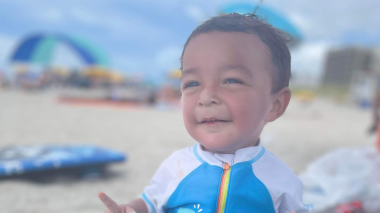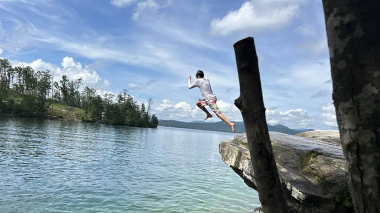If you’re headed to the beach or pool with children this summer, Dr. Rhonda Patt, a pediatrician at Atrium Health Levine Children’s Charlotte Pediatrics, offers health and safety recommendations to help the whole family enjoy fun in the sun.
What to Pack: Beach and Pool Essentials for Kids
Start by filling your beach bag with these essentials recommended by Dr. Patt:
- Water
- Snacks
- Sunscreen (choose a broad-spectrum option with at least SPF 30)
- Flip-flops or sandals
- Wide-brimmed hats (baseball caps don’t provide adequate sun protection)
- Sunglasses with at least 99% UV protection
- Hand wipes to clean off sand before eating
- A small first aid kit for minor cuts and scrapes
- An umbrella for shade
- Flotation devices, like a life jacket or puddle jumper, for little ones playing near the water who cannot swim
- A whistle to call for help if needed
Patt emphasizes that flotation devices don’t replace adult supervision but add an extra layer of protection for youngsters.
Sun Safety Tips for the Whole Family
Sunscreen is a must for every family member anytime you go outside, especially for beach and pool days. Patt recommends applying broad-spectrum, water-resistant sunscreen with at least SPF 30 before going to the beach or pool. Reapply sunscreen every two hours and after swimming, sweating or toweling off.
One sunscreen caveat: Babies under 6 months shouldn’t wear sunscreen, as they are more susceptible to side effects, like rashes.
“Instead, protect your baby’s skin with a hat and sun-protective clothing and keep them in the shade,” she says. “It’s also important to try to avoid the beach during the hottest part of the day: 10 a.m. to 4 p.m.”
If sun exposure is unavoidable, Patt says you can apply a mineral-based formula with zinc oxide or titanium dioxide, which are generally less irritating. Be sure to wash off the sunscreen at the end of the day. Note: Always check with your pediatrician before applying sunscreen to a baby who’s less than 6 months old.
Swimming Safety for Kids
“Water safety and drowning prevention are such important topics, and summer is a great reminder of this,” says Patt. “Swimming lessons provide one level of protection against drowning, especially for young children.”
In addition to signing them up for swimming lessons, teach your child these basic water safety rules:
- Swim near a lifeguard.
- Never get in the water without an adult present.
- Never dive headfirst into the water without knowing the depth of the water.
- No wrestling or rough play around the pool.
- Avoid swimming in water when there are rip current advisories.
- If you get caught in a rip current, remain calm and don’t try to fight against it. Float, wave and yell to get attention, or swim parallel to the shore (if you’re a good swimmer). If you see someone in a rip current, find a lifeguard for help, throw them a flotation device or offer them a reaching object. Never attempt to make the rescue on your own.
- Monitor the weather and stay out of the water if lightning is in the area or if you hear thunder.
“If a child cannot swim, they should wear a U.S. Coast Guard-approved floatation device when playing around the water,” says Patt.
Even if your child knows how to swim, you should always designate an undistracted adult “water watcher” who can keep an eye on everyone at all times. Flotation devices are never a replacement for swim lessons and adult supervision.
“I also recommend that all parents and caregivers learn CPR,” she says.
Choosing the Safe Swimsuit
The color of your child’s bathing suit is a key factor of water safety. Choosing vibrant colors that are highly visible in various water conditions, including pools, lakes, and oceans, can help lifeguards and parents spot children quickly and easily.
When choosing a swimsuit for your child, consider the following:
- Avoid darker or more muted tones.
- Wearing bright colors like yellow, orange and green can make your child more visible in the water.
- Your child should not wear colors that blend into the water or surroundings, such as blue, green and black.
- Additionally, white bathing suits can be less visible due to water reflections and glare.
To keep your child safe in and around the water, it's best to choose bright, neon colors that stand out clearly against their surroundings. Choosing the proper swimsuit is a simple, but important, step to water safety this summer.
Preventing Dehydration and Heat Illness in Children
“Children and infants can become overheated in the summer,” says Patt. “Parents should especially be aware of this with infants because they are often dressed in extra sun protective clothing and are not in the water.”
Here are some ways to keep babies and kids safe in high temperatures:
- Ensure they’re well-hydrated and drink plenty of water (or breastmilk/formula for infants). Avoid sugary beverages.
- Encourage them to take breaks and rest indoors or in the shade.
- If it’s over 90 degrees outside, consider visiting the beach or pool on another day or keep your visit short.
- Dress them in loose-fitting, light-colored clothing.
Call your pediatrician if you notice any of the following symptoms in a child or infant after spending time outdoors in the heat:
- Extreme fatigue or unusual sleepiness
- Faintness
- Fever
- Headache
- Not urinating for several hours
- Nausea
- Vomiting
- Intense thirst
- Muscles aches or spasms
- Skin tingling or numbness
- Breathing deeper or faster than usual
With these safety tips in mind, you and your family can enjoy plenty of fun in the sun this summer.
Does your child need a pediatrician? Find one near you.



